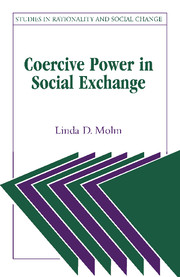Book contents
- Frontmatter
- Contents
- LIST OF FIGURES AND TABLES
- PREFACE AND ACKNOWLEDGMENTS
- 1 Introduction and overview
- 2 Social exchange and power
- 3 Punishment and coercion
- 4 An experimental setting for studying power in exchange relations
- 5 The early research: experimental tests and theoretical puzzles
- 6 The structural determination of power use
- 7 Dependence and risk: structural constraints on strategic power use
- 8 Injustice and risk: normative constraints on strategic power use
- 9 The effects of coercion: compliance or conflict?
- 10 A theory of coercion in social exchange
- 11 Conclusions and implications
- APPENDIX I Definitions of basic concepts of social exchange
- APPENDIX II The experimental instructions for the standardized setting
- REFERENCES
- NAME INDEX
- SUBJECT INDEX
7 - Dependence and risk: structural constraints on strategic power use
Published online by Cambridge University Press: 06 July 2010
- Frontmatter
- Contents
- LIST OF FIGURES AND TABLES
- PREFACE AND ACKNOWLEDGMENTS
- 1 Introduction and overview
- 2 Social exchange and power
- 3 Punishment and coercion
- 4 An experimental setting for studying power in exchange relations
- 5 The early research: experimental tests and theoretical puzzles
- 6 The structural determination of power use
- 7 Dependence and risk: structural constraints on strategic power use
- 8 Injustice and risk: normative constraints on strategic power use
- 9 The effects of coercion: compliance or conflict?
- 10 A theory of coercion in social exchange
- 11 Conclusions and implications
- APPENDIX I Definitions of basic concepts of social exchange
- APPENDIX II The experimental instructions for the standardized setting
- REFERENCES
- NAME INDEX
- SUBJECT INDEX
Summary
The preceding chapter developed the thesis that punishment power is less effective than reward power because its use is not structurally induced by power advantage. Unlike reward power, coercion is not an unintended by-product of actors seeking exchange with alternative partners. Instead, it must be used strategically, by actors punishing their partners' failure to reward. The effective use of power strategies requires more information, skill, and behavioral monitoring than structurally induced power use. On this basis alone, then, we would expect to observe some differences in the use and effects of the two bases of power.
But we would not expect to find the very low rates of punishment that all subjects, even those with a strong incentive to coerce, have repeatedly displayed in these experiments. Actors might use punishment ineffectively and inconsistently, but why should they use it so infrequently? And why does punishment always decline, before it has any chance to influence the partner's behavior?
This chapter begins to answer these questions, by developing and testing a theory of strategic power use. Although Emerson included voluntary modes of power use within the scope of his theory, he assumed that they were fairly irrelevant; structure would determine power use in any event. Consequently, he made few assumptions about the decision-making processes of individual actors.
In this chapter I draw on theories of choice and decision making to explain how the strategic use of both bases of power – but especially coercive power – is constrained by risk and fear of loss.
- Type
- Chapter
- Information
- Coercive Power in Social Exchange , pp. 160 - 189Publisher: Cambridge University PressPrint publication year: 1997

